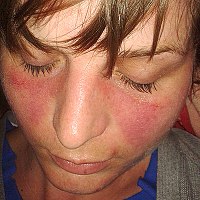
Photo from wikipedia
Importance Cutaneous lupus erythematosus (CLE) can be severe and treatment resistant. B-cell depletion therapy (BCDT) with rituximab is well recognized in organ involvement in systemic lupus erythematosus (SLE), but its… Click to show full abstract
Importance Cutaneous lupus erythematosus (CLE) can be severe and treatment resistant. B-cell depletion therapy (BCDT) with rituximab is well recognized in organ involvement in systemic lupus erythematosus (SLE), but its efficacy in cutaneous manifestations is less well established. Objective To evaluate the outcomes of BCDT in CLE and its clinical subtypes in the setting of associated SLE. Design, Setting, and Participants This single-center, retrospective, cohort study was performed at the adult tertiary referral Rheumatology Department of University College London Hospital, London, United Kingdom, from January 1, 2000, through March 31, 2016, with 12-month follow-up completed on March 31, 2017. Adult patients with carefully classified CLE and mucocutaneous British Isles Lupus Assessment Group (BILAG) grade A or B who were treated with rituximab BCDT were selected from a prospective database of 709 patients with SLE. Data were analyzed from April through December 2017. Main Outcomes and Measures Clinical response was examined at 6 and 12 months after treatment for CLE and its subtypes acute CLE (ACLE), subacute CLE (SCLE), chronic CLE (CCLE), and nonspecific LE (NSLE). A complete response was defined as achieving BILAG grade D; partial response, BILAG grade C; stable disease, no change; and disease flare, change from BILAG grade C or D to grade A or B. Results A total of 50 patients with SLE were eligible for inclusion; mean (SD) age at diagnosis was 26.9 (12.1) years, and 49 (98%) were women. Twenty-one patients had ACLE; 6, SCLE; 10, CCLE; and 11, NSLE (including 2 with concurrent ACLE and CCLE). Overall, at 6 months, 38 patients (76%) improved their mucocutaneous BILAG grade A or B status, including 20 (40%) with a complete response. At 12 months, 28 of 46 patients (61%) maintained this response, including 24 (52%) with a complete response. Two of 6 patients (33%) with SCLE showed a complete response at 6 and 12 months. Five of 12 patients (42%) with CCLE showed a complete response at 6 months, and 5 of 11 (45%), at 12 months. Fifteen patients (30%) required further rituximab therapy within 12 months for cutaneous involvement. Conclusions and Relevance B-cell depletion therapy using rituximab appears effective in patients with SLE and severe active CLE; however, outcomes are variable in those with SCLE and CCLE subtypes.
Journal Title: JAMA Dermatology
Year Published: 2018
Link to full text (if available)
Share on Social Media: Sign Up to like & get
recommendations!